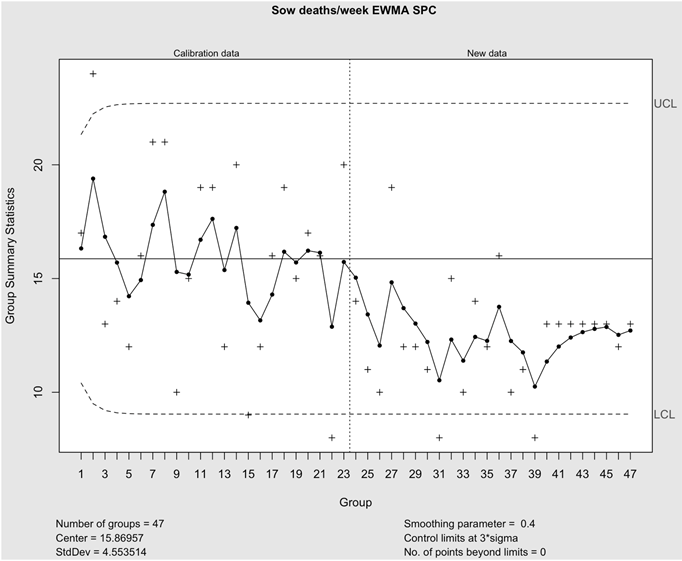Investigators targeted at-risk females in the breeding and gestation phase to reduce weekly sow deaths on a commercial sow farm.
May 3, 2022

Sow mortality has significantly increased over the past five years in the U.S. swine industry1. One database suggests that there has been a 50% increase in annualized sow mortality between 2015 and 20201.
As breeding herds have increased in size and the available labor force has decreased, one area that is often neglected is critically evaluating breeding females for treatment, particularly in the breeding and gestation phase, even though they typically spend 85% of their reproductive lives there.
As part of the NPB-FFAR funded Survivability project, the investigators were determined to see if early identification and treatment of at-risk sows in the breeding and gestation phase could reduce weekly sow deaths on a commercial sow farm. A 4,000 head, commercial breeding herd was used in this evaluation. The herd is endemic for porcine reproductive and respiratory syndrome virus, Mycoplasma hyopneumoniae and Influenza A virus. The breeding herd is housed in individual gestation stalls where breeding and gestation occur. Breeding females were fed once per day at 6 a.m., via a drop feeding automated system.
The methodology to improve the early identification and treatment of at-risk sows was to inspect each sow in breeding and gestation as feed was dropped. Two teams of two people were deployed for a two-week time period (Monday-Friday), which took place on weeks 24 and 25 of 2021. One Iowa State University veterinarian was teamed with a gestation barn manager and walked one gestation row at a time, with one person in the front of the stalls and the other person behind the stalls.
The primary indicator of an at-risk sow was one that was not up and eating at the time of feeding. Sows were encouraged or assisted to stand and then the evaluators performed a physical exam, including taking a rectal temperature. At-risk sows were flagged by hanging a card in front of the gestation stall with the appropriate reason, noted on the card. Information regarding the at-risk sow was recorded onto a daily form. The farm staff would return later to re-evaluate the sow, review the reasons they were flagged, consult the farm's sow treatment protocol, then provide and record the appropriate treatment. The time that the two teams started and finished the evaluation process was recorded each day.
Weekly sow deaths were the outcome measured. Weekly sow deaths from weeks 1-23 of 2021 (baseline period) were compared to weeks 24-48, 2021 using statistical process control charting. The Exponentially Weighted Moving Average was calculated for each period and then plotted on a EWMA chart using a lambda of 0.4 and a S.D of 3.0 (Table 1). To compare the change in % annualized sow mortality between the two time periods a chi-squared test for trend in proportions was performed using R program.
Results
When evaluating weekly sow deaths, a significant reduction was detected following training on identification and treatment of at-risk sows in breeding and gestation (Table 1). The staff was able to maintain and improve on this reduction in sow mortality well beyond the two weeks of training. The breeding herd inventory during the entire evaluation period remained static, therefore weekly sow deaths were a good proxy for annualized percentage of sow mortality.
When comparing weeks 1-23 to weeks 24-48, there was a 4.25% reduction in sow mortality (from 16.75% to 12.50%). There was a linear trend suggesting a decrease on the % annualized sow mortality between the two time periods (p=0.007). All of this occurred independently of any additional effort in the farrowing rooms, even though the weekly sow deaths included deaths from both breeding, gestation and farrowing.
Discussion and conclusions
This evaluation demonstrates the opportunity to reduce sow mortality by prioritizing the identification and treatment of at-risk breeding females. For many health conditions, one of the primary signals of illness and discomfort is anorexia. In a system where all breeding/gestation breeding females are fed once per day at the same time, this can be used as an early signal to identify a breeding female that may need more thorough evaluation and treatment. The gestation barn staff can flag at-risk sows during feeding and come back later in the day to perform the follow-up assessment and treatment.
The additional time commitments to do this on a daily basis resulted in an increase in 0.2 FTE to the farm, which was offset by the time savings in having to remove dead females from the stalls and moving them through the breeding and gestation buildings in addition to the opportunity costs in sow mortality and replacement costs.
This training has been replicated across other breeding herds in the same system and sow mortality across the system is beginning to see a tangible decrease. This evaluation appears to be the application of the Individual Pig Care system to breeding and gestation sows in that the earlier that at-risk breeding females are detected and treated, the more successful the outcomes of those treatments and therefore a reduction in sow mortality is subsequently observed.
References:
PigCHAMP Benchmarking Summaries. https://www.pigchamp.com/benchmarking/benchmarking-summaries. October 5, 2021

Sources: Chris Rademacher, Justin Brown, Gabi Doughan, Meredith Petersen, Megan Nickel, Swaminathan Jayaraman, Daniel Linhares and Locke Karriker, who are solely responsible for the information provided, and wholly own the information. Informa Business Media and all its subsidiaries are not responsible for any of the content contained in this information asset.
You May Also Like



